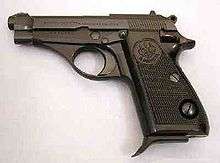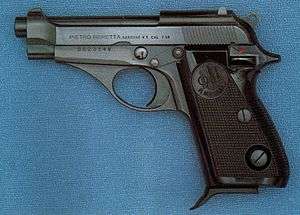Beretta 70
| Beretta 70 Series | |
|---|---|
|
The Beretta 70 in .32 ACP (7.65mm Browning) | |
| Type | Semi-automatic pistol |
| Place of origin | Italy |
| Production history | |
| Manufacturer | Beretta |
| Produced | 1958-1985 |
| Specifications | |
| Weight |
|
| Length |
|
| Barrel length |
|
| Height |
|
|
| |
| Cartridge | .32 ACP, .380 ACP, or .22 LR |
| Action | Single Action |
| Feed system | 7, 8, 9, or 10 round detachable magazine |
| Sights | Fixed or Adjustable |
The Beretta 70 was a semi-automatic pistol series designed and produced by Beretta of Italy,[1] which was based on the earlier 7.65mm Beretta M1935 pistol.[2] Some pistols in this series were also marketed as the Falcon, New Puma, New Sable, Jaguar, and Cougar[3][4] (not to be confused with the later Beretta 8000, which was also marketed as Cougar). The gun is notable for its appearances in film, and is also the first compact Beretta pistol to feature several improvements commonly found in Beretta pistols for the rest of the century.[2]
Improvements over previous Beretta pistols
The 70 Series improved upon the M1934/M1935 (and the later .22 LR offering of the same as the Model 948) in several ways. The swivel-lever safety of the M1934/35 was too difficult to operate one handed, so the 70 Series started out with the same cross-bolt safety as the M1951,[4] but this safety was also difficult to operate with a single hand, and could also accidentally be switched on or off depending on the user's grip. After only a few years, the cross bolt safety was replaced with the thumb-activated, frame-mounted lever safety found on most Beretta pistols in the latter half of the 20th century, and indeed most single-action or traditional double-action semi-automatic pistols in production today, until the relocation of the safety to the slide with the Model 92S in 1983.[4]
As the replacement for the M1934/5 in Beretta's compact/medium pistol line, the Model 70 integrated the M1951's takedown lever, guide rod system, slide stop, and magazine release button in the lower part of the grip. The M1934/5 would hold open on empty due to the magazine follower blocking the slide, but removing the magazine would cause the slide to be released unless its safety was subsequently engaged (which would lock the gun open until switched back to Fire mode); this process was slow and cumbersome, which is why the slide stop improvement was implemented in the M1951 and later models of service pistols.[5] The slide stop changed partway through the production run of the pistol from the same "pedal" style release as the M1951 to a round button at the end of the lever. A softer, longer curve that tapered up to the front of the gun was also added to make the trigger guard more sleek. Near the end of its production, the same thumb shelf of the 76W's left grip panel was added to the 70S.[4]
The magazines retain the spur at the front of the floor plate, common to both the M1934/5 and M1951, as is common for many pistols with a European-style magazine release (a hinged latch in the bottom of the grip against the magazine's floor plate), and also some compact pistols as a means of extending the grip surface while keeping the profile of the pistol small.
Models
71
The Model 71 is the same as the 70, except it was only available in lightweight alloy (not steel), which reduced the weight of the pistol by about 200 grams, and was chambered in .22 LR. The 71 (and 72) was marketed as the Jaguar.[3]
72
The Model 72 was the same as Models 71 and 75, except it was supplied with two barrels: one short barrel for self-defense, and one long barrel for target shooting.[5] This model was also marketed as Jaguar.[3]
73, 74, 75
Models 73, 74, and 75 were target models with a longer barrel than the others. Model 74 featured adjustable sights mounted on the barrel.[4] Models 73 and 74 are taller, full-sized frames, whereas the 75 retains the compact frame of the other models.[5]
76
The Model 76 is much more distinctive, with a barrel shroud integrated with the frame, similar to the later Beretta 87 Target, with a rail for mounting optics. Produced from 1971 to 1985, it features the same full-size frame as models 73 and 74. Its sights are adjustable, but the rear sight is mounted to the barrel shroud instead of the back of the barrel as on the 74, giving it a longer sight radius and greater accuracy. The Model 76 was available with either plastic or wooden grips, and respectively suffixed as 76P or 76W.[5]
100, 101, 102
The 100 series pistols were identical to the 70 series, but were briefly marketed in the United States as the such in the late 1960s. The Model 100 was a .32 ACP with the longer, 150mm barrel and the grip frame of the .22 caliber model; apart from its weight of nearly a kilogram, the pistol's remaining attributes are identical to the Model 74. Model 101 was identical to the Model 71, and Model 102 was identical to Model 76. This numbering scheme was dropped in the mid 1970s, when the original Model 70 designation was resumed.[4]
| Model | Caliber | Barrel Length | Magazine Capacity | Rear Sight | Front Sight | Weight |
|---|---|---|---|---|---|---|
| 70 | .32 ACP | 90 millimetres (3.5 in) | 8 | Fixed | Fixed | 660 grams (23 oz) |
| 520 grams (18 oz) | ||||||
| 70 S | .380 ACP | 90 millimetres (3.5 in) | 7 | Fixed | Fixed | 675 grams (23.8 oz) |
| 70 S | .22 Long Rifle | 90 millimetres (3.5 in) | 8 | Adjustable | Fixed | 635 grams (22.4 oz) |
| 71 | .22 Long Rifle | 90 millimetres (3.5 in) | 8 | Fixed | Fixed | 480 grams (17 oz) |
| 72 | .22 Long Rifle | 150 millimetres (5.9 in) | 8 | Fixed | Fixed | 535 grams (18.9 oz) |
| 90 millimetres (3.5 in) | ||||||
| 73 | .22 Long Rifle | 150 millimetres (5.9 in) | 10 | Fixed | Fixed | 550 grams (19 oz) |
| 74 | .22 Long Rifle | 150 millimetres (5.9 in) | 10 | Adjustable | Fixed | 570 grams (20 oz) |
| 75 | .22 Long Rifle | 150 millimetres (5.9 in) | 8 | Fixed | Fixed | 525 grams (18.5 oz) |
| 76 | .22 Long Rifle | 150 millimetres (5.9 in) | 10 | Adjustable[6] | Replaceable[6] | 930 grams (33 oz) |
| 76S | .22 Long Rifle | 150 millimetres (5.9 in) | 10 | Adjustable[6] | Replaceable[6] | ≈800 grams (28 oz) |
| 100[4] | .32 ACP | 150 millimetres (5.9 in) | 9 | Adjustable | Fixed | 990 grams (35 oz) |
| 101 | .22 Long Rifle | 150 millimetres (5.9 in) | 10 | Adjustable | Fixed | - |
| 102 | .22 Long Rifle | 150 millimetres (5.9 in) | 10 | Adjustable[6] | Replaceable[6] | - |
Versions
No special designation was made for it, but the Model 70 was available with a threaded barrel and detachable suppressor.
Base versions (no letter suffix)
The Model 70 series, without suffix, was manufactured from 1958-1968. At some point in this period, the frame-mounted thumb safety was adopted, replacing the older cross-bolt safety of the Model 951.[3]
S version
The S version was introduced in 1977,[3] included a new magazine safety,[3][4] and marked the adoption of caliber .380 for the Model 70, to replace .32 ACP. The .22 caliber guns had adjustable rear sights, but the .380 did not. Production ceased in 1985.[3]
T version
The T version was produced from 1969 to 1975, and featured a 9-round magazine (+1 from base models) and lengthened 6" (152mm) target barrel.[3]
Users
In popular culture
In the film The Spy Who Loved Me, the Beretta 70 erroneously serves as James Bond's service weapon instead of his iconic Walther PPK during the pyramid scene.[8] The Model 70 is use by Inspector Clouseau in the 1963 film The Pink Panther.[9]
In the movie Skyfall, James Bond is talking to Severine in the Macau casino. Bond says, "only a certain kind of woman wears a backless dress with a Beretta 70 strapped to her thigh."
Given its extensive use in Italian film as a police service weapon,[1] a compilation album of theme songs from those films was released under the title "Beretta 70: Roaring Themes From Thrilling Italian Police Films 1971-80".[10]
Ellie has one in The Last of Us.
Gallery
-

Model 76 with wooden grips
-

Model 70 with newer thumb-operated manual safety, flat grips, and early model magazine release button
-

Model 70S with thumb-rest grip and late model magazine release button
External links
References
- 1 2 "Beretta Model 70 - Internet Movie Firearms Database - Guns in Movies, TV and Video Games". Imfdb.org. Retrieved 2014-05-31.
- 1 2 "Beretta Web 70 Series". Berettaweb.com. Retrieved 2014-05-31.
- 1 2 3 4 5 6 7 8 Ramage, Ken (2008). The Gun Digest Buyers' Guide to Guns. Krause Publications. ISBN 1440224331.
- 1 2 3 4 5 6 7 8 Wood, JB (1985). "10 - Model 70 Series Pistols". Beretta Automatic Pistols: The Collector's And Shooter's Comprehensive Guide. United States: Stackpole Books. pp. 122–139. ISBN 0811704254.
- 1 2 3 4 5 Massad Ayoob (28 February 2011). Gun Digest Book of Beretta Pistols: Function Accuracy Performance. Iola, Wisconsin: Gun Digest Books. pp. 43–44. ISBN 1-4402-2424-2.
- 1 2 3 4 5 6 Sights affixed to detachable counterweight
- ↑ Jacobellis, Nick (2009-05-04). "Israeli Mossad .22 LRS: The Reliable Pistols of the Mossad". Tactical-life.com. Retrieved 2014-05-31.
- ↑ "Spy Who Loved Me, The - Internet Movie Firearms Database - Guns in Movies, TV and Video Games". Imfdb.org. Retrieved 2014-05-31.
- ↑ "Pink Panther, The (1963) - Internet Movie Firearms Database - Guns in Movies, TV and Video Games". Imfdb.org. Retrieved 2014-05-31.
- ↑ Beretta 70: Roaring Themes From Thrilling Italian Police Films 1971-80 (Vinyl) Crippled Dick Hot Wax. Release Date: September 29, 1998
| Wikimedia Commons has media related to Beretta 70. |

